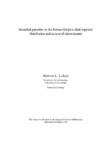Ledger, Marissa
As one of the main categories of pathogens, an understanding of parasitic infection in the past is essential to understanding disease in past populations. Evidence for parasites in the human past is steadily growing with examples from many different continents and time periods. Studies have been done in the Roman period however, this evidence does not cover all regions of the Roman empire. At its greatest extent the empire covered much of Europe, North Africa, and parts of the Middle East and different regions had strong cultural influences, not only from pre-existing cultural groups, but also from connections outside the empire. For these reasons there are likely to be variations in disease presence regionally. One of the main aims of this dissertation is to illuminate possible regional variations in parasitic infection in the Roman empire and compare this to earlier and later time periods in order to consider possible explanations for parasite taxonomic diversity in the empire. Archaeological sediments were collected from Roman period sites in previously understudied regions, such as Italy, Turkey, and the frontier regions, as well as pre-Roman and post-Roman time periods that had limited or no data. These samples were analysed for preserved parasite eggs and cysts using microscopy and enzyme-linked immunosorbent assay (ELISA). In the Roman period, predominately soil-transmitted helminths were found in samples from the Mediterranean region while those from northern Europe had additional zoonotic taxa. In the pre-Roman period the taxonomic diversity found was much higher, especially at the Bronze Age site of Must Farm in the marshes of Britain. The parasites found in the post-Roman sites studied here were very similar to that in the Roman period. A consideration of sanitation infrastructure presence, design, and use based on archaeological and historical evidence points to some potential reasons for the consistent presence of roundworm and whipworm across the Roman empire. Additionally, differences in diet, cooking practices, animal husbandry, and climate are considered as contributors to taxonomic diversity in different regions of the empire.Keywords
Palaeoparasitology, Helminths, Protozoa, Roman Empire, ArchaeoparasitologyIdentifiers
This record's DOI: https://doi.org/10.17863/CAM.55497Rights
All rights reserved, All rights reserved, All rights reserved, All rights reserved, All rights reserved, All rights reservedLicence:http://www.rioxx.net/licenses/all-rights-reserved
Advisors
Mitchell, PiersDate
2019-11-01Awarding Institution
University of CambridgeQualification
Doctor of Philosophy (PhD)Type
Thesis










 Stumble It!
Stumble It!

No comments:
Post a Comment